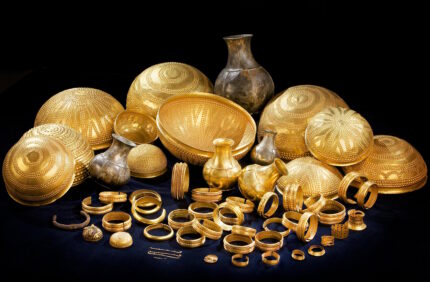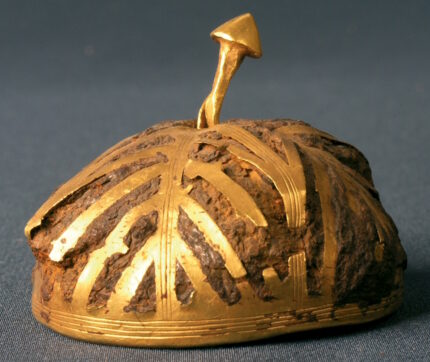 Analysis of two iron objects in the Treasure of Villena, the Bronze Age gold hoard discovered in southeastern Spain in 1963, have identified the metal as meteorite iron. The treasure is the largest and most important Bronze Age hoard ever found in the Iberian Peninsula, and the second largest set of prehistoric goldsmithing in Europe after the riches found in the Royal Tombs of Mycenae, Greece. Now we know it is also the only hoard on the Iberian Peninsula to contain objects made from meteoric iron.
Analysis of two iron objects in the Treasure of Villena, the Bronze Age gold hoard discovered in southeastern Spain in 1963, have identified the metal as meteorite iron. The treasure is the largest and most important Bronze Age hoard ever found in the Iberian Peninsula, and the second largest set of prehistoric goldsmithing in Europe after the riches found in the Royal Tombs of Mycenae, Greece. Now we know it is also the only hoard on the Iberian Peninsula to contain objects made from meteoric iron.
The first pieces of the treasure were found loose in a gravel pit on December 1, 1963. Workers found a gold bracelet and took it to a jewelry store where they were informed it was enormously valuable by weight alone, never mind its historic significance. Archaeologist José María Soler heard about the find and quickly followed up with an excavation of the pit. Soler and local volunteers unearthed the rest of the treasure grouped together in a large ceramic vessel.
The hoard consists of 66 pieces, most of them gold, nine of them 23.5 carat gold. The 11 bowls, 28 bracelets, three bottles and miscellaneous fragments of decorative elements made of gold all together weigh 9.75 kilos (21.5 lb). There are also three bottles made of silver (600 grams, 1.3 lb, total weight), a gold and amber button and the two iron pieces that were the subject of the recent study.
 Iron was extremely rare in Bronze Age Spain, and therefore considered a precious metal like gold and silver. The iron in the Villena hoard is the oldest in Spain. The objects are an open bracelet with rounded ends and a hollow hemisphere of iron covered with thin bands of gold incised with decorated lines that may have been a sword pommel. The corrosion of the iron over the centuries has broken and deformed some of the gold strips.
Iron was extremely rare in Bronze Age Spain, and therefore considered a precious metal like gold and silver. The iron in the Villena hoard is the oldest in Spain. The objects are an open bracelet with rounded ends and a hollow hemisphere of iron covered with thin bands of gold incised with decorated lines that may have been a sword pommel. The corrosion of the iron over the centuries has broken and deformed some of the gold strips.
The discovery of the treasure caused a sensation at the time, and garnered enormous scholarly attention. Experts have long debated its date range. The metal analysis that revealed the meteorite iron also conclusively answered the dating question: the Villena Treasure dates to the Late Bronze Age (1,400-1,200 B.C.)
Their analysis has been able to determine that these are not pieces made with terrestrial iron produced by the reduction of minerals existing in the mantle of planet Earth. Instead, they are “extraterrestrial and [were] made during the Late Bronze Age.” To obtain this data, two tiny extractions were made, under the supervision of the technical staff of the Alicante museum. The samples were then taken to Madrid for analysis at the laboratory of the National Archaeological Museum.
“Meteorite iron is found in certain types of aerolites that, since they come from outer space, are composed of an iron-nickel alloy with a variable nickel composition greater than 5% by weight. They also contain other minor and trace chemical elements, cobalt being one of the most significant. However, the levels of nickel in terrestrial iron are generally low or very low and frequently not detectable in analysis,” the study explains.
The study has been published in the journal Trabajos de Prehistoria and can be read here. The treasure, which has been on display at the Villena Museum since its discovery, will soon move to a new state-of-the-art facility. The new Villena Museum (MUVI), located in a restored 1909 flour mill, opens on May 17th with the Treasure front and center in a spacious 800-square-foot room.
Meteoritic iron could have been collected from all kinds of places, but the contemporary trading routes definitely need a closer inspection. The other iron piece looks like a bronze Age ingot. In addition, likewise from Alicante, but a few centuries younger, is the famous “Lady of Elche”.
Before the Iron Age (with terrestrial iron), the Egyptians made an iron dagger that looks brand new of meteoritic iron for King Tut, and they had gold, ivory and amber. On the Iberian Peninsula, they used gold, meteoritic iron, amber and ivory. Just in between, in Mycenae, (some) people used gold, amber, ivory and –maybe or maybe not– meteoritic iron.
…what the “hemisphere of iron” covered with thin bands of gold, incised with decorated lines, with a diameter of 4.5cm, looks like –i.e. a mycelium with fruit– obviously the content management prevents me from describing.
Psilocybe hispanica is a species of fungus with conical to convex caps up to 10mm (0.4in) in diameter and stems 16 to 25mm (0.6 to 1.0in) long by 0.5 to 1mm (0.02 to 0.04in) thick.
A possible depiction of this species is the 6,000-year-old Selva Pascuala rock art with fungiform representations, near Villar del Humo, province of Cuenca, Castile-La Mancha, Spain.
It is “coprophilous” (=”dung loving”), which also makes clear, what the meteoric iron bit is supposed to resemble.
Besides, the “Eberswalde Hoard” –81 gold objects with a total weight of 2.59kg, eight gold bowls that contained another 73 gold objects, thin-walled chased gold vessels with copious ornamental decoration– closely resemble the Treasure of Villena from Spain.
—-
“Both smelted iron and meteoritic iron was used on rare occasions in the second and third millennia BC – Iron from heaven” in Hittite is “An.Bar Ge”, derived from “An.Bar” = (smelted) iron. We also have “An.Bar Sig” = good iron, “An.Bar Baba” = white iron, and so on.
One doesn’t need to be fluid in Hittite to realize that you only can name some kind of iron “An.Bar Sig” if you know An.Bar = iron in the first place. Not to mention that some meteorite found somewhere does not bear the inscription “I fell from heaven” on it.
—-